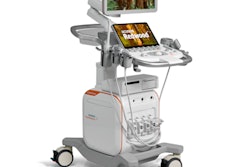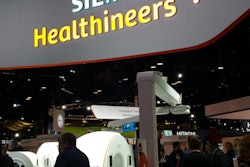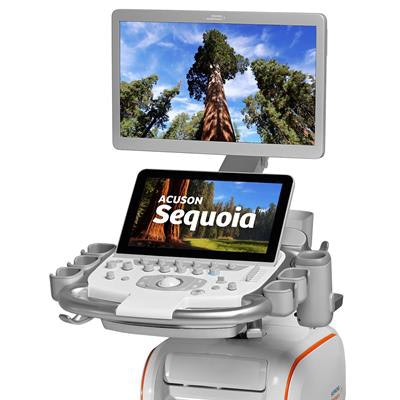
Siemens Healthineers is looking to revive one of the most storied brands in radiology with the launch of a brand new Acuson Sequoia scanner this week. While the name may be familiar, the new Sequoia is an entirely new platform designed to address many of the limitations of existing ultrasound technology.
The original Sequoia 512 scanner was a technological marvel when it was launched by ultrasound vendor Acuson in 1996, soon becoming synonymous with high-quality, no-compromise radiology ultrasound. Siemens acquired Acuson in 2000, and Sequoia went on to become one of the best selling ultrasound scanners in history by dollar volume until the product was discontinued in 2008. In fact, the scanner was so groundbreaking that a Sequoia is part of the permanent collection in the Smithsonian.
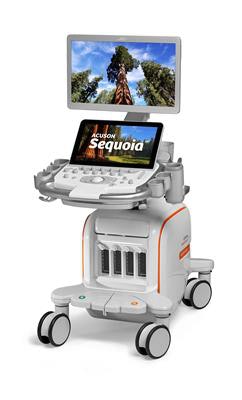 Siemens is reviving the Acuson Sequoia brand with its new scanner. All images courtesy of Siemens.
Siemens is reviving the Acuson Sequoia brand with its new scanner. All images courtesy of Siemens.Several years ago, Siemens began a research campaign to find out what customers considered to be the gold standard in ultrasound, and one name kept coming up: Sequoia, according to Miguel Trigueiros, global director of product marketing for ultrasound at the company's ultrasound headquarters in Mountain View, CA.
"We went back and looked at what ultrasound was known for, and what was the gold standard that we could build on and evolve," he told AuntMinnie.com. "It was clear. One name kept coming up -- Sequoia."
The research also covered three major pain points in terms of users' perceptions of ultrasound:
- Acoustic biocharacteristics such as patient anatomy that can attenuate ultrasound signals
- Technology trade-offs such as accepting worse image resolution in exchange for deeper tissue penetration
- User-specific variability, which requires that users have a high degree of skill to capture diagnostically relevant images
The new Sequoia addresses these challenges with an entirely new architecture designed from the ground up, according to Trigueiros. It includes a variety of new technologies designed to improve the ability to scan large patients, enhance elastography and contrast imaging, and adapt to the needs of users through machine learning.
For example, the company's Deep Abdominal Transducer (DAX) technology is a new transducer architecture that supports penetration up to 40 cm, compared with 18 cm to 19 cm for older transducer technology. This opens up a whole new population of patients to ultrasound scanning who previously had to be referred for MRI or CT.
With respect to elastography, DAX enables clinicians to measure tissue up to 14-cm deep in the abdomen, compared with 8 cm previously, preserving up to six times more energy. This will produce a cleaner shear-wave elastography signal, Trigueiros said.
A new bioacoustic imaging technology preserves the acoustic fidelity of the B-mode ultrasound signal and adapts to variations in each patient. It will also improve the longevity of bubbles used for ultrasound contrast exams, giving clinicians more time to scan for incidental lesions.
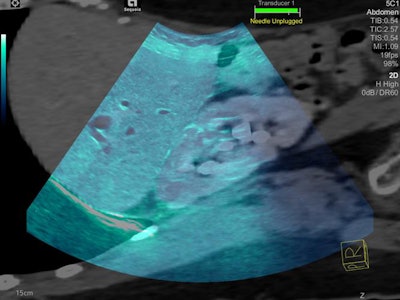 Bioacoustic imaging technology preserves the acoustic fidelity of the B-mode ultrasound signal and adapts to variations in each patient.
Bioacoustic imaging technology preserves the acoustic fidelity of the B-mode ultrasound signal and adapts to variations in each patient.The scanner provides high-resolution InFocus imaging from the near field to the far field in real-time, which means that users won't need to adjust the focal point of the scan. This will lead to faster scan times without compromising frame rates and resolution. Sequoia will also offer high-resolution color flow with three times the sensitivity and 20% deeper penetration.
Siemens didn't just focus on image quality with the new Sequoia, however. The company also addressed workflow, developing a variety of technologies to make the system easier to use and more intuitive. For example, transducers can be activated by tapping the probe twice rather than having to push a button on the console, and an InTune probe design is intended to reduce operator stress and increase comfort.
Sequoia also has a machine-learning element built in -- something not found on the 1996 edition of the scanner. First, the scanner selects the optimal transducer, preset, and protocol using factory settings with a feature Siemens calls one-click registration. But it's also capable of learning a user's preferences over time, adjusting its selections to match the user and improve workflow.
Finally, UltraArt is a technology that displays images processed through four automatically generated presets on the touch display in real-time; users can immediately select the preset they want to show on the main display. Sequoia also supports teamplay, the company's peer-to-peer image and protocol sharing network, which provides dashboards that enable users to monitor scanner and transducer use.
Siemens launched the new Sequoia at a special event on June 21 at Chihuly Garden and Glass in Seattle. To demonstrate the scanner's tissue penetration capabilities, the company enlisted Yama, a Japanese sumo wrestler and actor who tips the scales at 600 lb. The system has received both the CE Mark and 510(k) clearance from the U.S. Food and Drug Administration. Shipments will begin in the next three to four weeks.





